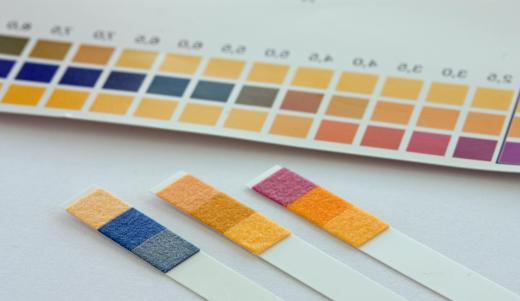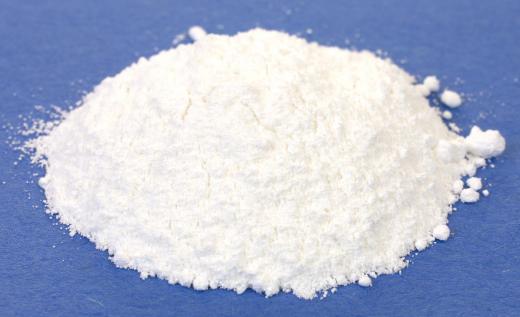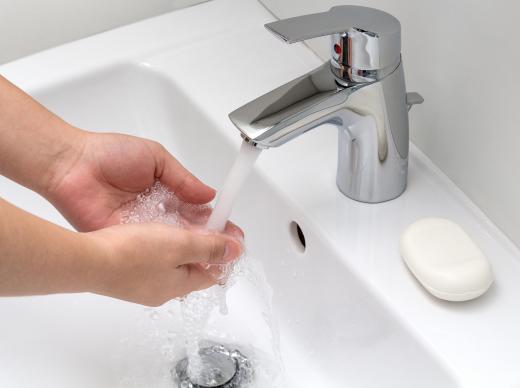How Do I Neutralize Sulfuric Acid?
There are several different approaches available to neutralize sulfuric acid — H2SO4 — depending on how precisely the process needs to be controlled and how the end product is to be handled. Concentrated sulfuric acid, like any type of acid, can be most easily neutralized by combining it with a material that has a basic nature on the pH scale with calcium carbonate, CaCO3, and calcium hydroxide, CaOH2, being two of the compounds most frequently used. Another common and effective way to neutralize sulfuric acid is to slowly mix it into equal or greater amounts of water, as pure water falls exactly in the middle of the pH scale with a rating of 7.
All neutralization refers to the process of taking either an acid or a base compound to a neutral or mid-range level on the pH scale, with an exact neutral reading being 7. When an acid with a lower-than-7 pH is being raised to a neutral level, this is often referred to as acid-neutralizing capacity, or ANC. When a base solution is being lowered from a higher-than-7 pH to a neutral level, this is referred to as lowering its alkalinity, or positive ANC.

Since the hazards of sulfuric acid include causing severe skin or mucous membrane burns and rapid chemical reactions with metals on contact, it is important that even diluted sulfuric acid be handled carefully. Sulfuric acid solution is usually sold in a concentration of 98%. To neutralize sulfuric acid with water so that it can be safely disposed of, the recommendation is that the acid slowly be added to a volume of cold water that is ten times greater than the volume of acid. The acid then can be taken beyond a neutral pH of 7 by adding compounds such as sodium carbonate or sodium hydroxide that can raise its base level up to a pH of 9 if necessary.

Diluted sulfuric acid with a concentration of 50% or lower can be more easily handled. One of the recommended methods to neutralize sulfuric acid concentrations that are weak involves adding small amounts of sodium bicarbonate, more commonly known as baking soda, to the liquid and observing the results. The acid will foam as it reacts with sodium bicarbonate and, when this foaming process is no longer observed, the solution has reached a safe neutral-to-base pH level of between 6 to 9.

Though many compounds can be used to neutralize sulfuric acid, several common ones are often used. Some of these are more suitable to laboratory settings as they are dangerous on their own, such as caustic soda, NaOH. Ammonia compounds are also a common neutralizer with a basic nature, such as ammonium hydroxide, NH4OH. Chemicals that are abundant and easy to come by include calcium carbonate that is more often referred to as lime or limestone, and calcium hydroxide.
AS FEATURED ON:
AS FEATURED ON:













Discussion Comments
@ anon344349: If you put sodium bicarbonate, or any other highly alkaline directly on the acid, it will create a reaction that will burn the person even worse. It needs to be flushed with a lot of water ASAP, then baking soda can be used to help get in and finish neutralizing the acid. It's usually better to mix the baking soda with water so it will not have a strong reaction in case there is undiluted acid.
I'm working in a plant where we use 92-93 percent concentration of H2SO4 and 10 sec. is too late to avoid permanent damage to skin so ''immediate medical attention'' is nothing else than words. Plus rinsing it with water can burn cause the exothermic reaction acid-water, but for few acid and a lot of water that could be OK. One product we know to be good is ‘’Diphoterine.’’
It is always recommended you use water first, and then baking soda.
As to acid attacks, many "dangerous areas" as you call them are taking steps to remove highly acidic substances (like noted here, 98 percent concentration and higher, the stuff that does really bad damage in those rare, but horrific events) from the mainstream markets. IDs are now required to purchase those acids and forms relaying the intention of the purchase are also mandatory. Courts are giving harsher sentences to acid-throwers, which will discourage those attacks. Furthermore, as education takes off in those alleged dangerous areas, attacks like this are alleviated as people learn the whole extent of what they are doing and learn to solve problems verbally.
But, if you are worried, carry a bottle of water and a bit of baking soda with you in your bag or backpack if you are traveling. I think that's a perfectly wise decision if you are worried. Most attacks result from jilted lovers or abusive husbands, wives, or just other sick and twisted individuals. Activism is on the rise to stamp this out, though, and we're seeing great progress.
If someone is the victim of an acid-throwing attack, can sodium carbonate or bicarbonate be used to help neutralize the acid safely?
Obviously, immediate medical attention is required, and several buckets worth of water should be used to wash the stuff off. But that might not be immediately available.
If traveling to dangerous places, can carrying a box of baking soda or washing soda be recommended?
Post your comments